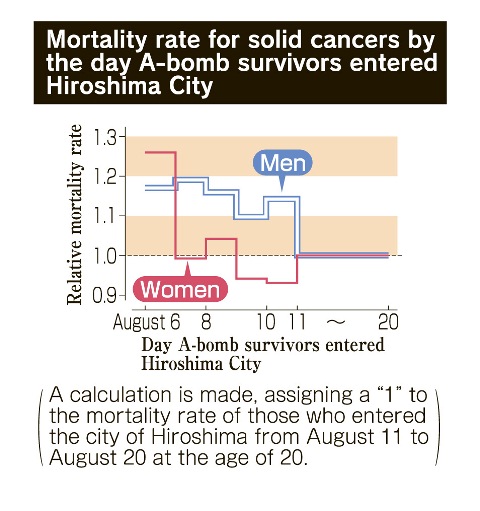Cancer mortality higher for those who entered hypocenter area within three days of A-bombing
Sep. 25, 2012
by Tomomitsu Miyazaki, Senior Staff Writer
New research has found that among people who entered the city of Hiroshima in the aftermath of the atomic bombing and came within roughly 2 kilometers of the hypocenter by August 20 (so-called “entrant hibakusha”), the mortality rate for solid cancers for those who entered this area by August 8 is 13% higher for men and 8% higher for women, compared to those who entered the area subsequently.
The findings were made by a team of researchers, including Megu Ohtaki, a professor at Hiroshima University’s Research Institute for Radiation Biology and Medicine (RIRBM). Their results confirm that indirect exposure to residual radiation and radioactive fallout had a greater impact on the human body in the immediate aftermath of the blast than in later days.
The researchers followed, until the end of 2009, 47,144 entrant hibakusha (27,062 men and 20,082 women) who were alive on January 1, 1970 and were registered on the RIRBM database. Assigning a “1” to the mortality rate of those who entered the city of Hiroshima from August 11 to August 20, they calculated, using cause of death, the relative mortality rate of those who had entered the city by August 8.
After employing a method known as “statistical optimization processing,” they found that the men who entered the hypocenter area within three days of the atomic bombing had a roughly 13% higher risk of developing solid cancers. The women in the same category had about an 8% higher risk when compared with other entrant hibakusha. Solid cancers include stomach cancer and liver cancer, but not leukemia.
Keiko Otani, an assistant professor who led the analysis of the data, pointed out, “Before, it was believed that the effects caused by indirect exposure were insignificant. But we now suspect that the impact is much greater than conventional thinking.” Ms. Otani stressed, “The effects of indirect radiation exposure on the A-bomb survivors who were directly exposed to the bomb’s radiation must be reassessed, too.”
Keywords
Entrant hibakusha
Under the Atomic Bomb Survivors Relief Law, those who entered an area within roughly two kilometers of the hypocenter within 15 days of the atomic bombings (in the case of Hiroshima, by August 20) are known as “entrant hibakusha” and are considered atomic bomb survivors. As of March 2012, there are 27,665 entrant hibakusha, making up 28.9%, among the 95,586 A-bomb survivors who hold the official A-bomb Survivor’s Certificate issued by Hiroshima Prefecture and the City of Hiroshima.
(Originally published on September 17, 2012)
New research has found that among people who entered the city of Hiroshima in the aftermath of the atomic bombing and came within roughly 2 kilometers of the hypocenter by August 20 (so-called “entrant hibakusha”), the mortality rate for solid cancers for those who entered this area by August 8 is 13% higher for men and 8% higher for women, compared to those who entered the area subsequently.
The findings were made by a team of researchers, including Megu Ohtaki, a professor at Hiroshima University’s Research Institute for Radiation Biology and Medicine (RIRBM). Their results confirm that indirect exposure to residual radiation and radioactive fallout had a greater impact on the human body in the immediate aftermath of the blast than in later days.
The researchers followed, until the end of 2009, 47,144 entrant hibakusha (27,062 men and 20,082 women) who were alive on January 1, 1970 and were registered on the RIRBM database. Assigning a “1” to the mortality rate of those who entered the city of Hiroshima from August 11 to August 20, they calculated, using cause of death, the relative mortality rate of those who had entered the city by August 8.
After employing a method known as “statistical optimization processing,” they found that the men who entered the hypocenter area within three days of the atomic bombing had a roughly 13% higher risk of developing solid cancers. The women in the same category had about an 8% higher risk when compared with other entrant hibakusha. Solid cancers include stomach cancer and liver cancer, but not leukemia.
Keiko Otani, an assistant professor who led the analysis of the data, pointed out, “Before, it was believed that the effects caused by indirect exposure were insignificant. But we now suspect that the impact is much greater than conventional thinking.” Ms. Otani stressed, “The effects of indirect radiation exposure on the A-bomb survivors who were directly exposed to the bomb’s radiation must be reassessed, too.”
Keywords
Entrant hibakusha
Under the Atomic Bomb Survivors Relief Law, those who entered an area within roughly two kilometers of the hypocenter within 15 days of the atomic bombings (in the case of Hiroshima, by August 20) are known as “entrant hibakusha” and are considered atomic bomb survivors. As of March 2012, there are 27,665 entrant hibakusha, making up 28.9%, among the 95,586 A-bomb survivors who hold the official A-bomb Survivor’s Certificate issued by Hiroshima Prefecture and the City of Hiroshima.
(Originally published on September 17, 2012)








